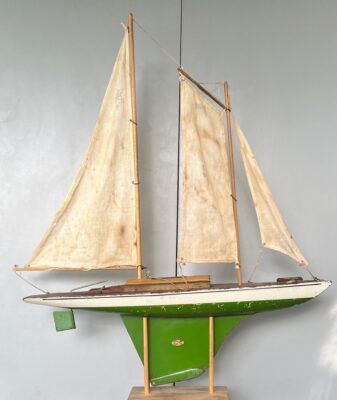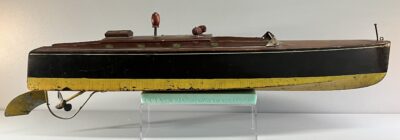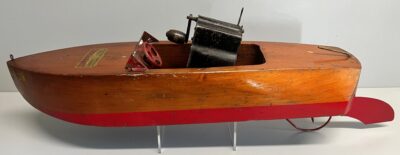Keystone Manufacturing
by Derrick Clow, collectingkeystone.com
The story of Keystone Manufacturing begins with three different toy companies and evolves into three separate Keystone companies. There were several key players that moved throughout the various companies holding different management positions. Unlike most toy companies, Keystone was started with the help of another local toy company. The formation of the company is a bit complicated, so often the story has been muddled by inaccuracies. Keystone manufacturing was founded in 1919, but the story really starts with the Marks Brothers Toy Company.
To find the beginnings of the Marks brother’s influence on Keystone one must look at where, particularly, Isadore Marks came from. There is a succession of Mark’s family companies that would lead to the making of toys. The earliest mention of Isadore is as a manager for the Marks Specialty Company in 1909. While the beginning of this company is unknown it appears to have been in existence through 1913 manufacturing primary paper goods at 41 Washington Street, Boston.
In 1914, the company Marks & Knoring, a partnership with Abraham J. Knoring, another Russian immigrant, was formed. The company was in business through 1917 moving several times around Boston. Isadore appears to have been president throughout the company’s existence. Early on they were the makers of household articles and water filters. In 1916 Marks & Knoring started making dolls, or at least doll parts. On February 19, 1917, there is an article in the Boston Globe about a two-alarm fire on the upper two floors of a four-story building. The fire was fueled by celluloid. The article mentions Marks & Knoring as a toy manufacturer.
1917 sees the rise of two Marks companies. Joseph Marks Company and Moss & Marks Company Inc. Joseph Marks Company was run by Joseph, Benjamin, and Isadore Marks, all brothers. Moss & Marks Co. listed Isadore as president. I could find nothing about Moss & Marks Co., but the company is of interest because they were located at 101 Albany Street, Boston, which would become the address of Keystone Manufacturing 3 years later. Joseph Marks Company would not survive the year before becoming the Marks Brothers Company by September. Interestingly the Marks Brothers Company was actually founded in 1915 with $80,000 capital as a toy manufacturer.
Their next venture would be Keystone Manufacturing with Edward M. Swartz in 1919. Isadore and Benjamin would dabble with one other toy company. In 1924 they would be involved in the Andrew Manufacturing Company which was listed as a doll manufacturer. It appears the company only existed for one year.
1919 would see the Marks Brothers Co. company move to 40 Winchester Drive for part of the year until finally moving to 615 Albany Street by the end of the year. Addresses become important, because as the Marks Brothers became involved in other toy companies. The various companies would move often until finally ending in one location functioning as home base for three separate toy companies.
 In 1919, the Marks Brothers were approached by Edward M. Swartz, another Russian immigrant, to produce moving picture and still projectors. The brothers signed on with Isadore becoming secretary. Edward was the president, and his mother-in-law, Jennie M. Wiesman, acted as treasurer. So, in 1919, Keystone Manufacturing Company was founded with $20,000 capital to build machines, etc. The first location of Keystone Manufacturing was 101 Albany Street, Boston in 1920. A year later Keystone would move to 53 Wareham Street and would remain there until 1924.
In 1919, the Marks Brothers were approached by Edward M. Swartz, another Russian immigrant, to produce moving picture and still projectors. The brothers signed on with Isadore becoming secretary. Edward was the president, and his mother-in-law, Jennie M. Wiesman, acted as treasurer. So, in 1919, Keystone Manufacturing Company was founded with $20,000 capital to build machines, etc. The first location of Keystone Manufacturing was 101 Albany Street, Boston in 1920. A year later Keystone would move to 53 Wareham Street and would remain there until 1924.
1924 would see the launch of the Keystone line of pressed steel toys. This new line of toys was modeled after the Packard trucks of the day. Each truck was prominently labeled with a Packard decal on the grill. The new line was met with great enthusiasm and quickly rivaled the popular Buddy L vehicles of the day.
With the need for more production space, Keystone moved again to 288 A Street, Boston in 1925. The same year Marks Brothers also moved to 288 A Street. There were now two toy manufacturers under the same roof. Both would remain there until 1942.
At this point we must backtrack a few years and add the third toy company into the story. Jacrim Manufacturing was founded in 1922 by Chester A. Rimmer and Arthur L. Jackson. The Jacrim name is a combination of the beginning of Arthur and Chester’s last names, Jac-rim. Both Chester and Arthur were 1921 graduates of MIT in Naval Architecture and Marine Engineering. Charles H. Jackson is mentioned as a founding member. The company was incorporated with $10,000 to deal in metal products of all kinds. The company was set up at 3 Cross Street, Malden, MA, a woodworking shop owned by Chester’s brothers. Chester’s brothers, David and John, were coopers and cabinet makers by trade. David and John would serve as president and secretary respectively until 1926.
In 1926, Jacrim moved to 615 Albany Street to use the space that had been occupied by Marks Brothers until 1924. At the same time Isadore Marks became president and Benjamin Marks became secretary of Jacrim. Chester Rimmer continued as treasurer. I am sure that this change of management forced the move. Arthur never held a position with the company and left in 1929 to pursue engineering. Jacrim would remain here until 1928 when they would move one more time to 288 A Street, Boston. Now there are three toy companies under one roof, Marks Brothers, Keystone Manufacturing, and Jacrim.
Jacrim manufactured wooden toys, primarily hand-crafted sailboats that were every bit as seaworthy as their full-sized counterparts. The line of sailboats was called “Seaworthy” because of this. Other toys were produced such as “Flying Yankee” motorboats; “Drive ‘Em” wagons and carts; wooden forts; and “Tom Thumb” ships, vehicles, and trains. All were handmade.
Jacrim would continue under its own name until it was dissolved and became a part of Keystone Manufacturing in 1934. Chester Rimmer stayed on and became president of Keystone Wood Toys in 1953, but we will get to that later. It is currently unknown, but one can assume that Chester worked in the design end of Keystone until then.
We left off with Keystone in 1925. Keystone over the next several years continued producing movie equipment and then started producing cameras and making the pressed steel vehicles. In 1928, when Jacrim moved into the same location. Jacrim continued to make the wooden toys and Keystone the pressed-steel. In 1932, Keystone started their new line of pressed-steel toys called “Ride ‘Em” toys. These toys were like the earlier steel toys except for the addition of a seat and a handle. The handle had the design of the wooden “Drive ‘Em” toys from Jacrim. This is the first example of crossover between the two companies.
1932 was also the start of Jacrim wooden toys being labeled “Jacrim by Keystone”. Two years later in 1934, Jacrim would be incorporated into Keystone, and the wooden toys were then labeled “Keystone”. The wooden toys were referred to as the Jacrim line in the Keystone catalogs until 1939.
In 1942, Keystone and Marks Brothers moved to 151 Hallet Street, Boston. This was originally the Hallet and Davis factory, a producer of musical instruments. With the outbreak of World War II, Keystone switched their production over to the war effort. Pressed steel toys were still offered for sale through the end of 1941. At least as early as February 1942 Keystone was producing radio filter boxes for jeeps and tanks. At some point during the war, Keystone produced large cameras for aircraft. Once the switch to the war effort happened, pressed steel toys were no longer produced. Wooden toy production continued through at least 1943. After that, wood production switched to making walnut rifle stocks for the war effort.
As an interesting side note is that during the war two men rented a space in the kiln building on the Keystone property and ran a cafeteria that sold doughnuts, coffee, and sandwiches. The workers would go there during their 10-minute morning and afternoon breaks as well as lunch. In 1950 the men ended their on-property business and moved down the street in Quincy to open the first Dunkin Donuts.
At the height of the company’s production, Keystone employed about 800 people for all of the lines. Each July with the start of the production ramp up to Christmas, Keystone would bring on another 400 workers through January. Many of these additional workers would come back each year for the 6 months of employment.
No catalogs or company ephemera have yet surfaced from 1943 through 1949, so this is currently a dark period in the Keystone story. Keystone did purchase all of the equipment from Kingsbury toys in 1944 when Kingsbury decided to not return to the toy business. In 1946, Keystone Wood Toys is mentioned as a taxable entity separate from Keystone Manufacturing. In early 1946, there was a fire at the factory. I found reference in a 1947 interview to the factory being closed for the last year but nothing to confirm or elaborate. Is it possible that the factory was closed due to the fire?
In July 1951, Isadore Marks died at age 63, and his brother, Benjamin Marks, took over as president. Benjamin retained this role for one year then disappeared from the record in 1953. Where he went is unknown, but this ended the involvement of the Marks brothers in Keystone Manufacturing. Benjamin Marks would die in March of 1956. In 1953 Edward Swartz took over as president and treasurer and would retain both roles until the company closed. In 1953 and 1954 the company went through major changes under Edward, splitting into Keystone Manufacturing, Keystone Camera Company, and Keystone Wood Toys. The main reason for the splits was to legitimize the camera and projectors as competitive options in the industry and distance them from the toy machines label. Keystone Manufacturing continued to produce the pressed steel toys; Keystone Camera Company produced cameras and projectors; while Keystone Wood Toys produced all of the wooden toys. When the company was divided, Keystone Wood Toys started production just down the street at 143 Hallet Street, Boston, with Chester Rimmer acting as president and treasurer. He would retain both roles until the company shut down. Keystone Camera Company set up shop at 135 Hallet Street. Edward Swartz was president and treasurer of Keystone Camera Company as well. While the management was fluid between the companies, one name is of note: Charles W. Kesselman. He began as a sales rep. for all three companies back in the early 1930s. By 1953 he had moved to the position of vice president of Keystone Wood Toys and sales manager of Keystone Manufacturing in the late 1950s.
The three companies would continue producing their products through the 1950s. In January of 1958, Keystone Wood Toys sold off all their equipment and closed shop. The equipment was purchased by the South Bend Toy Manufacturing Company of South Bend, Indiana. Chester Rimmer and Charles Kesselman are still listed as officers of Keystone Wood Toys in 1959 despite having no factory or equipment. Keystone Manufacturing would continue through 1959, possibly 1960. I found one advertisement from 1960 selling Keystone pressed steel toys. Keystone Camera Company moved back to 151 Hallet Street in 1961 and continued production. In 1965 the Camera Company was acquired by Berkley Photo and moved from Boston to Clifton, NJ in 1967. Keystone cameras continued as a product line for Berkley Photo throughout the 1970s.
Chester Rimmer stayed on through 1959 and eventually died in 1984 in Norwell, MA. It appears that sometime after the closing of Keystone Wood Toys, Chester attempted to go back into the toy business. A wooden boat, with its box, that is labeled “Admiral Chester” has surfaced.
One thing that has not been addressed in this timeline is the Marks Brothers Company. Like I stated earlier, not much is known about the company. At some point, likely in the 1930s, they stopped producing doll wigs and doll heads. In the 1930s their product lines included many games, soldier molding kits, wood burning sets, metal tapping sets, music boxes, and Disney toys. Marks Brothers was one of the early licensees for Disney products and Charlie McCarthy. The last record I found of the Marks Brothers Company is the company being located at 151 Hallet Street in 1949. It is my opinion, but unconfirmed, that the company closed with the death of Isadore Marks in 1951.
One other company that makes an appearance in this story is the Dover Film Company. Dover film would purchase unused surplus film, cut it down and repackage it for home use. Isadore Marks was the founder and president of this company from 1947 until his death. Dover Films had their offices at 151 Hallet Street from 1947 to 1959 while their factory was in Dover, NH.
Keystone Manufacturing was only in business for 41 years, but in my humble opinion is one of the most important toy companies of the early to mid-20th century. Keystone was instrumental in bringing movie projection into the home, produced pressed steel toys that rivaled any contemporary companies, and produced some of the most desirable wooden toys of the era.
Keystone was also one of the few companies to get a start with the help of another toy company and flourish while sharing a factory with the same company. The steel toys produced by Keystone have been prized and highly collectible for several years, and the wooden toys are starting to see a climb in value and collectability.
I want to address the issue of varying histories of Keystone Manufacturing. There are numerous histories out there on the internet and in several books. Most of them are only partly correct and some are just wrong. I went to great lengths in my research to ensure the accuracy of the history presented here. Every fact is backed by a printed bit of information that I possess. I spent years going through company catalogs, company ephemera, census data, business directories, phone directories, trade publications, newspapers, and even a college thesis paper from the 1940s. I feel this is the most correct and current history of Keystone Manufacturing and associated companies.
Other Manufactured Boat Articles
- Manufactured Boats Introduction
- Jacrim, Keystone, and Seaworthy Boats by Bob Jones
- Keystone Manufacturing by Derrick Clow
- Keystone Company Timeline by Derrick Clow
- Keystone Manufacturing Company Locations by Derrick Clow
- Model Yacht Manufacturers and Sellers
- Estimating the Year of Manufacture of a Boat: Jacrim, Keystone, Seaworthy by Bob Jones
- Keystone Toys by Derrick Clow






